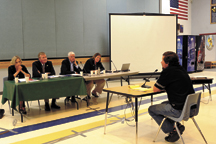

John Artorbum, senior fish biologist with the Colville Confederated Tribes, was the first to testify at the International Joint Commission’s public meeting held in Oroville. The IJC Commissioners in attendance were (L-R) Lana Pollack, U.S. Section Chair;
OROVILLE – With the current orders regulating Lake Osoyoos water levels about to expire next February, the International Joint Commission (IJC) held the first of two public comment meetings in Oroville last Tuesday, Aug. 4.
The IJC is a quasi-judicial body made up of commissioners from both the U.S. and Canada that set the lake levels for Lake Osoyoos and many other waters that span the two countries borders.
The IJC has commissioned eight scientific studies and they emphasized the need for good science and to listen to the citizens on both sides of the border.
“It’s an important part of the process to approving water levels,” said Rick Moy, one of four commissioners at the meeting, a fifth commissioner joined the hearing by phone from Ottawa.
Cynthia Barton, with the U.S. Geological Survey (USGS) made a presentation that outlined the goals for the new orders. The presentation included charts outlining the new rule curve that would, if approved, set the maximum level of the lake at 912.5 feet above sea level, rather than the current 913 feet.
“There’s still an opportunity to influence the order renewal, we are considering what we hear at the public meetings, emails and letters, as well as the eight studies and two science forums,” said Moy. “We need to use all the information we have gleaned in drafting recommendations on the order renewal.”
The board key recommendations include 1.) limiting lake level management, 2.) retaining Zosel Dam as constructed, 3.) retaining requirements to ensure flow capacity and 4.) have the same winter range as before 900.0′ to 911.5′, 5.) eliminate the drought designation, 6.) limit the maximum to 912.5 and 7.) help with flows downstream for fish.
“This whole idea of declaring drought or not declaring drought has always been controversial, this would eliminate that,” said Barton.
Barton added, “We want to hear back from you… where we have problems and can tweak this. After we hear input, we will take a look at what is proposed and may make some changes.”
Commissioner Moy said the board hoped to make the recommendation for renewal of the order by next fall.
The first person to comment was John Artorbum, senior fish biologist with the Colville Confedrated Tribes’ Fish and Wildlife Department.
“Most of my comments refer to water management. Regarding fish, we know that most water management has gravitated to human needs. I am asking you to consider those animals that also have needs,” said Artorbum.
He said that 2500 cfs would negatively impact spawning salmon and steelhead in the channel downriver.
“Be very careful when you talk about changing the channel,” he said, while commending other items in the plan and asking for further details on others.
He also said that although the Colville Confederated Tribes are a sovereign nation with many rights to the waters of the Okanogan, they were not mentioned.
“I think to omit a group that has a great deal to add to those discussions is a mistake,” he said.
Osoyoos Mayor Stu Wells, a member of the Okanagan Basin Water Board, testified that he had just a few quick points to make.
He commended the process and added he had concerns about the ability to keep the lake at or below 912.5′ when it was above right now and the gates on Zosel Dam were wide open.
Donald Burk, who has lived on the lake on the U.S. side for the last seven years said what would be most significant to him and others would be a way to determine lake levels before they put their docks out and their boats in. He also said he wished there was a way to eliminate the milfoil problem.
A total of five people made comments and the commissioners repeated that comments could still be made in writing and via email. Information on the process, current proposals and how to comment can be found at http://www.ijc.org.





